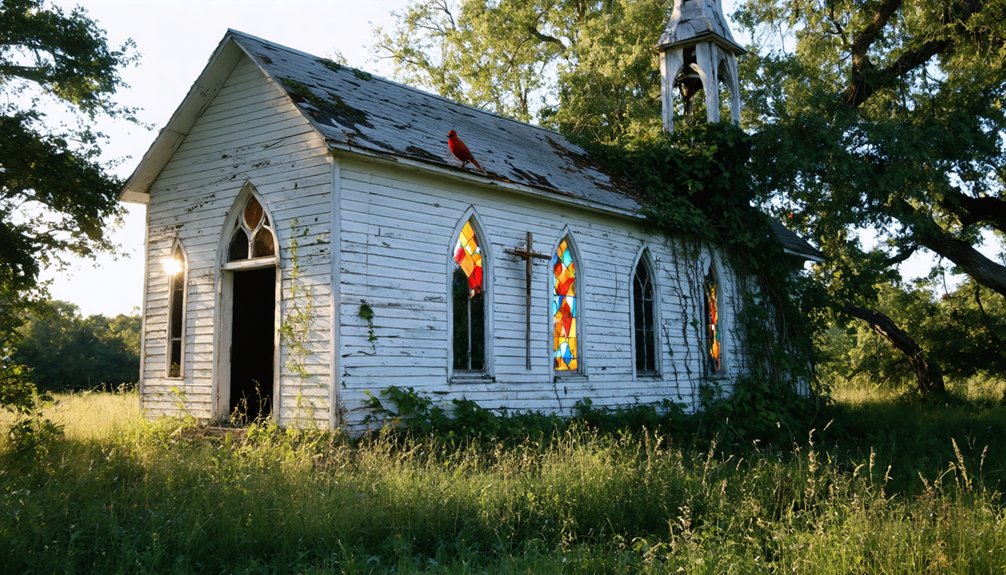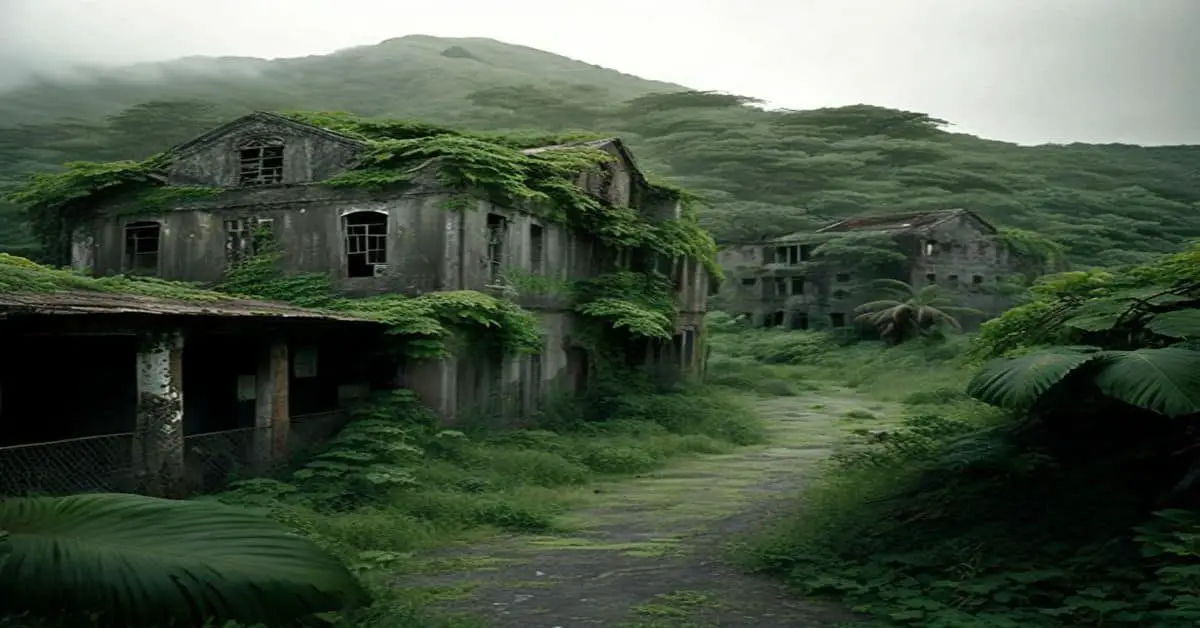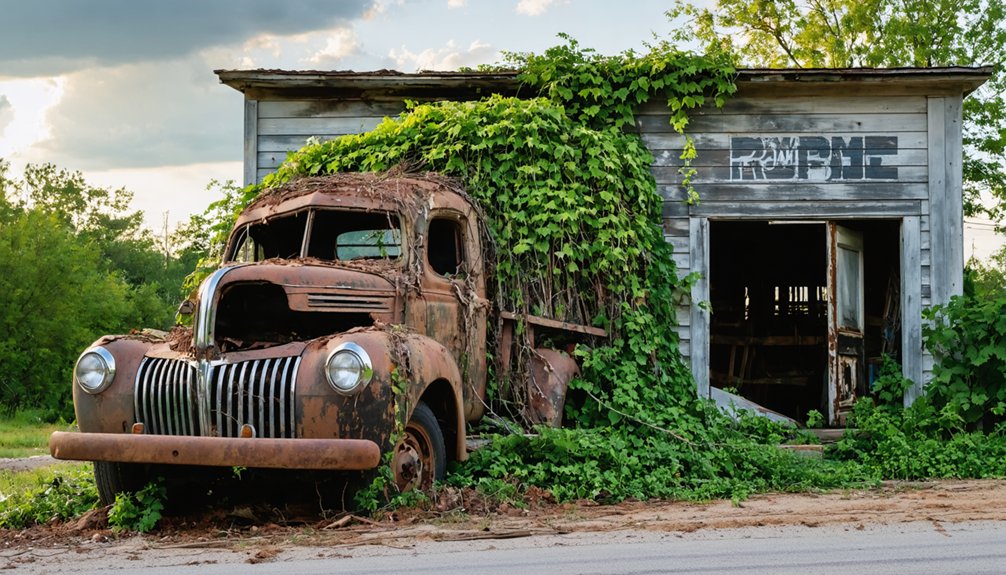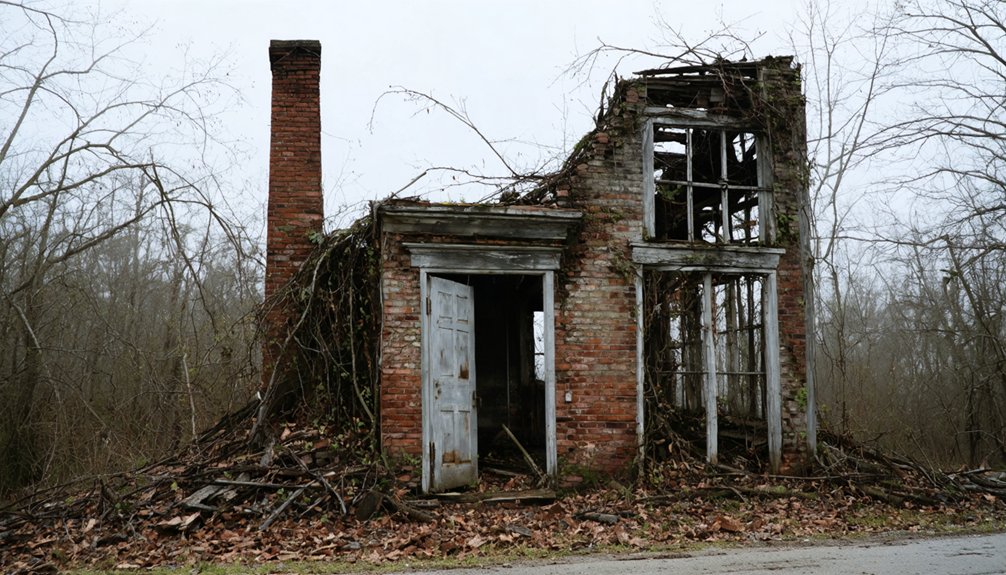You’ll find Pansey, Alabama about 13.5 miles east-southeast of Dothan along U.S. Route 84. This former farming community, established in 1902, thrived on cotton production until the devastating boll weevil crisis of the 1910s forced farmers to switch to peanuts. Today, the ghost town‘s abandoned buildings and empty streets tell stories of its agricultural past. The scattered artifacts and structural remains hold clues to this once-vibrant community’s rise and fall.
Key Takeaways
- Pansey, Alabama was established in 1902 and transformed from a thriving agricultural town into a ghost town following economic decline.
- The boll weevil crisis in the 1910s forced farmers to abandon cotton, leading to population migration and community deterioration.
- Few physical remnants remain, though archaeological surveys reveal scattered artifacts like ceramic vessels, glass bottles, and industrial items.
- Changes in transportation routes bypassed Pansey, isolating the community and making local businesses unsustainable.
- The town’s abandoned buildings and empty streets stand as silent reminders of its once-vibrant agricultural and social life.
The Origins of a Lost Settlement
While much of Alabama was undergoing significant administrative changes in the early 1900s, the small settlement of Pansey emerged as an incorporated town in 1902.
You’ll find this piece of Pansey history particularly interesting, as the town was established before Houston County even existed, originally belonging to Henry County until 1913.
Located 13.5 miles east-southeast of Dothan along what’s now U.S. Route 84, Pansey represented the typical rural Alabama community of its time.
Nestled along U.S. Route 84 near Dothan, Pansey embodied the essence of early twentieth-century rural Alabama life.
Similar to how Bootsville, Alabama briefly served as a county seat, Pansey played an important role in local governance during its early years.
Like its French namesake in the Haute-Marne department, this Alabama town quickly gained recognition with its own post office and ZIP code 36370, marking its importance in the region.
While many similar settlements were founded on mining or industrial pursuits, Pansey’s economy likely centered on agriculture and local trade, setting the stage for its eventual rural decline.
Life in Rural Houston County
Three distinct characteristics define life in rural Houston County today: its steady population growth, strong community bonds, and agricultural heritage.
You’ll find a population of just over 108,000 spread across nearly 580 square miles, creating tight-knit communities where neighbors know each other by name. Rural traditions remain strong here, with a largely White and African American population maintaining their cultural roots through community festivals and local gatherings. Since 2010, the area has experienced a 6.2% increase in residents.
While you’ll face typical rural challenges like aging infrastructure and limited job options, the area’s affordability is attractive, with median home values around $178,000. The median household income of $57,531 shows the area’s economic stability.
Your daily life revolves around a car-dependent culture with reasonable 22-minute commutes. Despite a 13.8% poverty rate, the county’s steady income growth and above-average safety ratings make it an appealing choice for those seeking a traditional rural lifestyle.
Agricultural Legacy and Community
You’d find Pansey’s early economy dominated by cotton farming, with plantations and small farms sending their harvests to market via mule-drawn wagons and later railroads.
Your daily life as a farmer would’ve revolved around dawn-to-dusk field work, equipment maintenance, and careful crop monitoring through the growing season. The entire family, including children as farmhands, worked together instead of attending school regularly. Dark, fertile soil from the Selma Chalk formation made cotton cultivation particularly successful in the region.
The tight-knit farming community pulled together through crop failures and the devastating boll weevil crisis, sharing labor, tools, and knowledge as agriculture shifted from cotton to peanut production in the early 1900s.
Cotton Farming And Trade
Cotton farming shaped the economic and social landscape of Pansey, Alabama, mirroring the broader agricultural patterns that dominated the state’s history. You’d have found the region’s farmers taking advantage of the fertile soil conditions, particularly during the industry’s peak in the mid-1800s when Alabama led the nation in cotton production.
The cotton trade in Pansey reflected the state’s broader agricultural evolution, from early plantation systems to post-Civil War sharecropping. Local farmers adopted improved farming techniques after the arrival of Eli Whitney’s cotton gin, which revolutionized cotton processing. The establishment of Pratt’s cotton gin in 1838 helped transform the agricultural capabilities of the surrounding region, including Pansey.
While the boll weevil devastation of the 1910s forced many Pansey farmers to diversify their crops, cotton remained an essential part of the community’s agricultural identity, shaping local commerce and social structures well into the 20th century. The area’s farms were predominantly operated by tenant farmers, with nearly 60% of Alabama’s farms under this system by 1920.
Daily Farm Life Routines
Life on a Pansey farm revolved around dawn-to-dusk routines that shaped the community’s agricultural identity throughout the late 1800s and early 1900s.
Your daily routines would’ve started before sunrise, tending to livestock and preparing tools for the day’s work. You’d have relied heavily on family labor, with everyone pitching in from planting to harvest.
Your farming practices would’ve followed the seasons religiously. In spring, you’d prepare soil and plant crops, often sharing labor with neighboring farms during busy periods. The farms were typically situated near the grist and sawmills that processed the community’s harvests. Like many agricultural communities that became ghost towns, Pansey’s success depended entirely on the farming industry.
Summer meant constant maintenance – hoeing weeds, maintaining equipment, and monitoring crops.
Come fall, you’d coordinate with family and hired hands for harvest, keeping detailed records of your yield.
Winter wasn’t idle; you’d repair tools, plan crop rotations, and tend to livestock while studying new agricultural techniques.
Community Support Networks
Throughout Pansey’s agricultural heyday, robust support networks formed the backbone of community survival and prosperity. You’d find neighbors helping neighbors during harvest seasons, sharing equipment, and providing mutual aid during tough times.
When the boll weevil devastated cotton crops, these networks became even more essential.
Cooperative farming emerged as an important strategy, allowing you to pool resources with fellow farmers and share expertise. You could access shared equipment, negotiate better prices for supplies, and learn new farming techniques from experienced neighbors.
Local organizations stepped in to provide training on alternative crops like peanuts, while government assistance programs offered critical support during shifts.
These community bonds helped you weather economic challenges and environmental setbacks, proving that survival in rural Alabama depended on working together.
The Vanishing Town
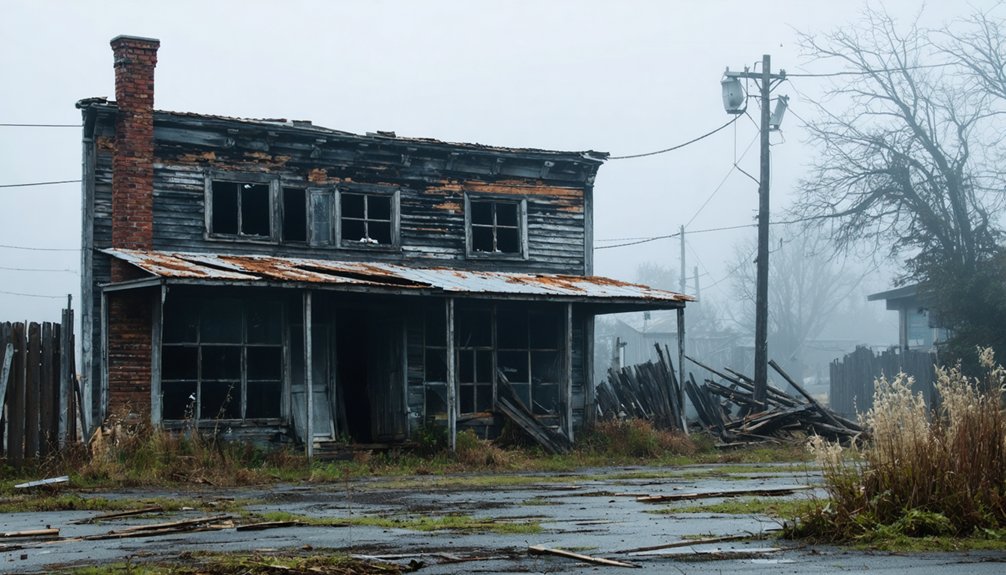
As economic pressures mounted in the late 19th century, Pansey, Alabama gradually evolved from a bustling agricultural community into a ghost town.
Population shifts and economic changes drove residents toward larger towns with better opportunities, leaving behind deteriorating infrastructure and abandoned homes.
Economic hardship scattered Pansey’s people to larger towns, transforming a vibrant community into decaying buildings and empty streets.
The town’s decline accelerated due to several key factors:
- Changes in transportation routes bypassed Pansey, reducing essential trade and commerce.
- Competition from larger economic centers made local businesses unsustainable.
- Limited access to major transportation arteries isolated the community.
You’ll find few remnants of Pansey’s former liveliness today.
The surrounding natural environment has reclaimed much of the land, while remaining structures have fallen into disrepair.
What was once a thriving rural community now exists primarily in historical records and ghost town enthusiasts’ documentation.
Historical Remnants and Traces
When you visit Pansey today, few visible remnants of its past can be confirmed through physical evidence or documented archaeological finds.
Despite the town’s listing as an Alabama ghost town, boundary markers, foundations, or other structural traces haven’t been reported in available historical records or field research.
No cemetery locations or marked grave sites connected to Pansey’s history appear in accessible sources, leaving the physical footprint of this former settlement largely undocumented.
Archaeological Evidence Today
Modern archaeological surveys of Pansey reveal a wealth of structural and material remains that paint a vivid picture of this former Alabama settlement.
You’ll find archaeological discoveries scattered throughout the area, from building foundations to riverbed artifacts, each holding historical significance in understanding daily life.
The site’s rich material culture includes:
- Household items like ceramic vessels, glass bottles, and personal effects that showcase resident life in the late 19th and early 20th centuries
- Industrial artifacts including quarry tools and metalworking remains that highlight local manufacturing
- Evidence of moonshine production through scattered jug fragments, reflecting the area’s connection to informal trade
Nearby family cemeteries with weathered headstones preserve the names of Pansey’s founding families, while river sediments tell the story of floods that influenced the town’s eventual abandonment.
Property Boundary Markers
Remnants of Pansey’s original property boundaries still dot the landscape through a variety of physical markers.
You’ll find weathered stone cairns and rusted iron pipes that once clearly defined property lines in this Alabama ghost town. Some of these markers align with early survey records from the 1800s, documented in county land records that followed the Public Land Survey System’s grid-based approach.
While wooden stakes have long since deteriorated, you can spot traces of old fence lines and stone walls that once separated neighboring properties.
Natural landmarks like distinctive trees and creek beds also served as boundary references.
Though many markers have vanished or deteriorated over time, the surviving ones provide valuable evidence of Pansey’s original layout and help preserve the town’s spatial history.
Cemetery and Grave Sites
The historic Pansey Cemetery stands as one of the most significant physical traces of this vanished Alabama community. Through cemetery preservation efforts, you’ll find over 300 graves scattered across this semi-wooded site, offering glimpses into the lives of early settlers, coal miners, and prominent local families.
You can explore these remnants of Pansey’s past through:
- Various grave markers ranging from formal headstones to simple field stones
- Unique inscriptions from fraternal organizations like the Lewis Hayden Lodge
- Evidence of original road placements and boundary shifts visible in the cemetery’s layout
Ground-penetrating radar has revealed burial sites extending beyond current property lines, while surrounding strip mining activities have dramatically altered the landscape.
Despite these challenges, the cemetery remains an essential connection to Pansey’s lost history for descendants and researchers alike.
Local Stories and Folklore
Deep within Alabama’s rich cultural tapestry, Pansey’s local stories and folklore have been passed down through generations, offering glimpses into the town’s fascinating past.
You’ll find that local legends often intertwine with the town’s natural surroundings, historical events, and the people who once called this place home. The oral traditions preserved by community elders tell tales of Pansey’s rise and eventual decline, while supernatural tales frequently center around abandoned buildings and the old cemetery.
Like many Alabama ghost towns, Pansey’s folklore reflects the cultural identity of its former residents, connecting modern visitors to the area’s colonial and territorial heritage.
Through storytelling events and local historical society efforts, you can still experience these narratives that keep the spirit of old Pansey alive.
Present-Day Ghost Town
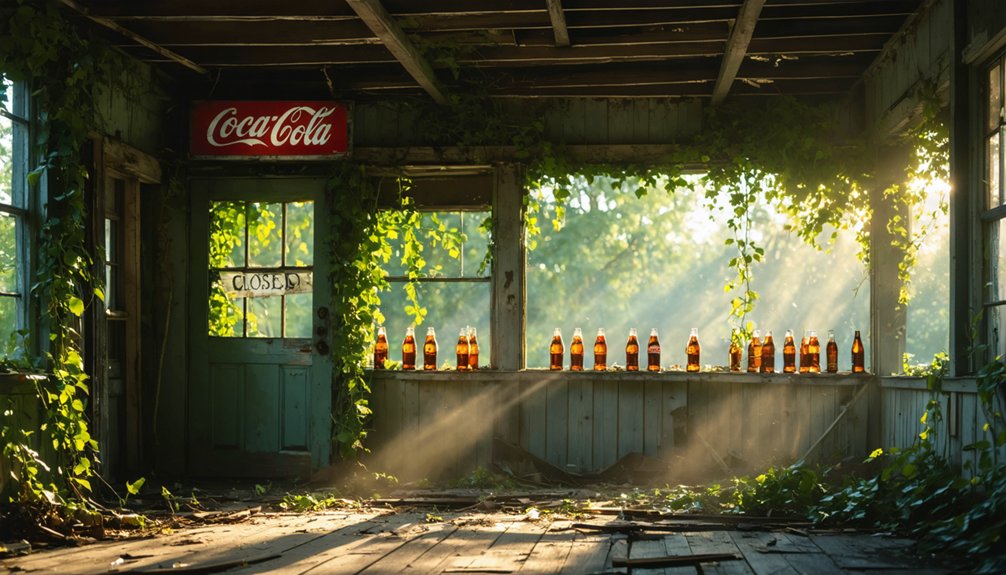
Standing quietly in Houston County, Pansey exists today as one of Alabama’s lesser-known ghost towns, marked by deteriorating structures and overgrown pathways where a community once thrived.
Unlike the state’s famous ghost town of Cahawba, you won’t find guided tours or archaeological exhibits here. Instead, you’ll discover a raw, untamed landscape where rural decay tells its own story.
- Abandoned structures dot the landscape, from weathered homes to old barns, all slowly returning to nature.
- Access remains limited, with unmarked routes leading to what’s left of this forgotten settlement.
- You’ll find no preservation efforts or tourist amenities – just the authentic remains of a once-vibrant rural community.
The site stands as a reflection of Alabama’s changing rural landscape, preserved only through historical records and local memory.
Exploring Pansey’s Past
Founded in the early 19th century amid Alabama’s post-Creek War expansion, Pansey emerged as a vibrant agricultural community in what was then Henry County.
When you investigate Pansey’s past, you’ll discover a town that thrived on cotton plantations and local commerce, supported by settlers who’d ventured from eastern states seeking new opportunities.
As you explore the town’s cultural significance, you’ll find a narrative that mirrors the broader story of the American South – from its early reliance on enslaved labor to the challenges of Reconstruction and the devastating impact of the boll weevil.
Today, historical preservation efforts help tell Pansey’s story through remaining markers and records, offering glimpses into 19th-century life and the complex social dynamics that shaped this once-bustling farming community.
Frequently Asked Questions
Were There Any Nearby Towns That Absorbed Pansey’s Remaining Population?
You’ll find that Dothan, Alabama, absorbed most of Pansey’s population migration, with other surrounding settlements taking in remaining residents who sought better economic opportunities during the 1920s decline.
Did Any Notable Historical Figures Ever Visit or Live in Pansey?
Historical records don’t show any influential residents or historic visitors to this area. You won’t find documentation of notable figures choosing to live in or pass through this rural community.
What Natural Disasters, if Any, Affected Pansey During Its Existence?
Like a mystery lost to time, you won’t find documented evidence of hurricane impact or flood damage in Pansey’s history. Available records don’t show any specific natural disasters affecting the settlement.
Were There Any Significant Disputes or Conflicts Within the Pansey Community?
You won’t find documented evidence of major community tensions or land disputes in Pansey’s history – while regional conflicts affected Alabama broadly, specific records of internal strife in Pansey don’t exist.
Did Pansey Have a Post Office or Railroad Connection During Its Existence?
Based on local post office history, you’ll find Pansey likely had postal services but lacked railroad significance. While nearby towns had rail connections, there’s no evidence of direct rail service in Pansey’s records.
References
- https://www.youtube.com/watch?v=d-Tuy6jw6TQ
- https://alabama.travel/upcoming-events/haunted-history-tours-13
- https://ahc.alabama.gov/properties/cahawba/cahawba.aspx
- https://www.blueridgeoutdoors.com/go-outside/ghost-towns-of-old-cahawba/
- https://digitalalabama.com/alabama-ghost-towns/alabama-ghost-towns/9449
- https://digitalalabama.com/topic/arbacoochee-alabama
- https://en.wikipedia.org/wiki/List_of_ghost_towns_in_Alabama
- https://en.wikipedia.org/wiki/Pansey
- https://freepages.history.rootsweb.com/~gtusa/usa/al.htm
- https://digitalalabama.com/series/alabama-ghosts-and-haunted-places
